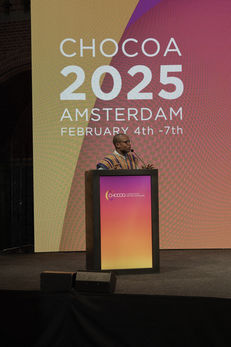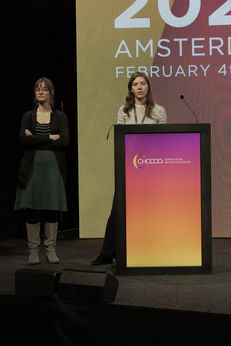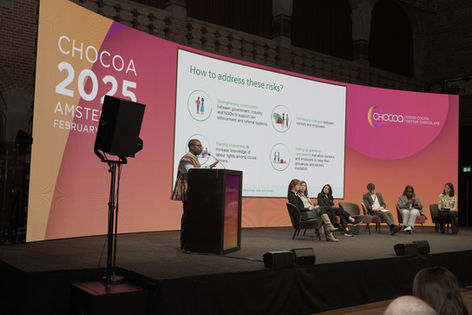
Chocoa 2025 Cocoa Sustainability Conference Recap
By CocoaRadar, Official Media Partner
With cocoa prices at historic highs and the EU Deforestation Regulation (EUDR) on the horizon, this year’s Chocoa Cocoa Sustainability Conference became the most urgent and impactful edition yet. Held over two days as part of Amsterdam Cocoa Week, the conference provided a platform for ministers, traders, farmers, scientists, retailers, and sustainability leaders to share their perspectives on the sector’s evolving conversation around resilience, compliance, and climate justice.
DAY 1: Facing the Inconvenient Truth
‘We Are Hitting Planetary and Human Boundaries’
Isabelle Van Tol, the Dutch Head of Trade for Development, opened the conference with a call for honesty. Amsterdam, as the world’s largest cocoa port, bears a special responsibility, she said. Highlighting that over 75% of cocoa farmers in Ghana and Côte d’Ivoire earn less than a living income, Van Tol warned:
“We are running into planetary and human boundaries, which endangers the security of supply.”
She urged better cooperation with producer countries and responsible implementation of EU directives like the Corporate Sustainability Due Diligence Directive (CSDDD) to avoid burdening smallholders.
Data, Compliance, and the EUDR Countdown
The importance of traceability took centre stage. Clive de Ruig of ICE introduced the new CoT platform, which validates farm origin and physical flow data—automatically issuing compliance badges. Anthony Mangnall, ICE’s Strategy Director and former UK MP, echoed the urgency, calling for alignment between regulation and reality:
“Lawful production must be provable, and the systems we build must work for farmers and companies alike.”
Michiel Hendriksz of FarmStrong Foundation added that deforestation in cocoa regions is often misunderstood, urging focus on the real drivers—timber, gold, and illegal activity.
The Market Outlook: Complacency and Climate Risk
“The Cheap Cocoa Era Is Over”
In a panel moderated by Michel Arrion (ICCO), market analyst Pam Thornton laid out stark trends:
-
Plateauing yields in West Africa
-
Climate instability and disease pressures
-
A lack of investment in scientific R&D
Thornton urged the sector to collaborate on forecasting tools, fund resistant cocoa strains, and stop treating regulation and innovation as adversarial.
Retailers and the Missing Middle
-
While retailers control assortments and messaging, their absence at Chocoa raised eyebrows. As moderator Anna Laven put it, “We asked them last year. This year, they were still missing. Maybe 2026?”
-
Still, discussions led by IDH, Tony’s Chocolonely, and others spotlighted new collaborative models:
-
Tony’s Open Chain now includes seven retailers
-
DISCO (Dutch Initiative on Sustainable Cocoa) promotes living income commitments
-
ChocolatsDeLuxe emphasized direct trade and consumer willingness to pay more for quality, sustainable chocolate
Joint Action and Landscape Solutions
The afternoon session tackled the big question: Can the sector truly collaborate in a competitive world?
Speakers included:
-
Peter Koegler (WCF): Urged public-private partnerships across Brazil, Nigeria, and Ghana.
-
Jonas Mva Mva (IDH): Outlined Cameroon’s deforestation-free cocoa roadmap.
-
Cédric van Cutsem (Mondelēz): Confirmed $1 billion Cocoa Life investment by 2030.
-
Alan Kroeger (Satelligence): Highlighted new carbon bureaus and insetting strategies.
-
Janice Weatherley-Singh (WCS): Advocated for forest-first policies and NGO roles as neutral intermediaries.
DAY 2: From the Ground Up: Farmers Take the Stage
“The Cocoa Farmer Should Not Be Alone”
Farmers from Côte d’Ivoire, Uganda, Nigeria, and Latin America took the floor in a powerful start to Day Two. Their message was consistent:
-
They face unpredictable weather, ageing trees, and legal hurdles to EUDR compliance.
-
Financing, innovation, and access to land documentation remain critical barriers.
-
The call: “We need investment, not charity. And a voice in pricing.”
Gerald Bagonza from Uganda’s Bwamba Coop Union emphasised knowledge sharing and crop finance access, while others spoke on the burden of monoculture and lack of visibility in decision-making.
Shining a Light on the Invisible Farmer
In a panel moderated by Anna Laven and Anika Altaf (INCLUDE Knowledge Platform), experts discussed the hidden workers and families behind cocoa’s indirect supply chain:
-
KIT, Wageningen University, and NewForesight presented new methodologies for tracking household income and living wage data.
-
International Cocoa Initiative (ICI) revealed that 1.5 million children in Côte d’Ivoire and Ghana are engaged in child labour.
-
Oyinkansola Owoyemi (Sunbeth Global, Nigeria) highlighted farmers’ “invisibility” despite Nigeria being the fourth-largest cocoa exporter.
Carbon Finance: Opportunity or Mirage?
Friday’s mid-morning session tackled carbon credits and insetting, with speakers offering hard truths:
-
Tropenbos Ghana explained their model where farmers retain 69% of carbon earnings—but the payout is still only ~$1 per farmer annually.
-
Terraton and ACT Commodities introduced biochar as a scalable solution, projecting $350K in profits for medium-scale projects.
-
Satelligence and Fairtrade discussed democratizing access for smaller producers to carbon markets.
Innovation and Disease: Future-Proofing Cocoa
In the final session, SwissDecode’s Gianpaolo Rando likened swollen shoot virus to a “COVID moment” for cocoa—fast-spreading, latent, and devastating. He argued for PCR testing, genetic resilience, and international cooperation.
Fanny Butler (Koltiva) reinforced the EUDR data challenge, highlighting fragmented supply chains, siloed platforms, and unequal access to technology. Her call: build systems that reward smallholders for transparency.
Then came the wildcard: Alex Shandrovsky of California Cultured, pitching lab-grown cocoa as the sector’s climate-resilient future. Greeted with scepticism, his pitch raised eyebrows but planted a seed.
“By 2032, 50% of cocoa farms may be non-viable. This is not science fiction—it’s insurance for a broken supply chain.”
CocoaRadar Takeaway: Cooperation or Crisis?
Chocoa 2025 offered a mirror to the cocoa industry. One that reflects hard truths—about farmer poverty, deforestation, and data inequity—but also one that shows possibility.
Whether it’s through EUDR readiness, carbon markets, AI-driven traceability, or climate-smart seeds, the tools exist. Now, it’s a question of will, trust, and shared investment.
As one farmer said: “Money is not a gift. It’s what we need to do our job. Sustainability must start with the producer.”

From The Desk of CocoaRadar’ goes out to more than 11,000 subscribers with a deeply vested interest in current events and trends and has become the ‘go-to newsletter‘ for the cocoa and chocolate industry. Chocoa readers can take advantage of an exclusive 90-day free trial to the 'go-to newsletter' for the industry and enjoy full premium benefits to help you stay in the loop with all the cocoa & chocolate news.
Sign up for free here and become a premium member to stay fully in the loop.
Official Media Partner
"From their desk to yours" – CocoaRadar delivers independent market analysis and trends, helping producers, traders and chocolate professionals make informed decisions - and will be covering the entire Chocoa 2026 program.
Enjoy an exclusive 90-day free trial to the 'go-to newsletter' for the industry and enjoy full premium benefits to help you stay in the loop with all the cocoa & chocolate news

Explore the 2025 Conference Photo Album

Join our Newsletter
Join our email list and get access to specials deals exclusive to our subscribers.











